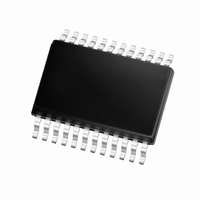MCP3909-I/SS Microchip Technology, MCP3909-I/SS Datasheet - Page 41

MCP3909-I/SS
Manufacturer Part Number
MCP3909-I/SS
Description
IC POWER METERING-1 PHASE 24SSOP
Manufacturer
Microchip Technology
Datasheets
1.MCP3909T-ISS.pdf
(44 pages)
2.MCP3909T-ISS.pdf
(104 pages)
3.MCP3909-ISS.pdf
(40 pages)
Specifications of MCP3909-I/SS
Package / Case
24-SSOP (0.200", 5.30mm Width)
Input Impedance
390 KOhm
Measurement Error
0.1%
Voltage - I/o High
2.4V
Voltage - I/o Low
0.85V
Current - Supply
2.3mA
Voltage - Supply
4.5 V ~ 5.5 V
Operating Temperature
-40°C ~ 85°C
Mounting Type
Surface Mount
Meter Type
Single Phase
Operating Temperature Range
- 40 C to + 85 C
Mounting Style
SMD/SMT
Supply Voltage Range
4.5V To 5.5V
Digital Ic Case Style
SSOP
No. Of Pins
24
Interface Type
Serial, SPI
Supply Voltage Max
5.5V
Rohs Compliant
Yes
Lead Free Status / RoHS Status
Lead free / RoHS Compliant
For Use With
MCP3909EV-MCU16 - EVALUATION BOARD FOR MCP3909MCP3909RD-3PH1 - REF DESIGN MCP3909 3PH ENGY MTR
Lead Free Status / Rohs Status
Lead free / RoHS Compliant
Available stocks
Company
Part Number
Manufacturer
Quantity
Price
Part Number:
MCP3909-I/SS
Manufacturer:
MICROCHIP/微芯
Quantity:
20 000
4.4
© 2009 Microchip Technology Inc.
PHASE LAG CALIBRATION
The phase lag calibration function is implemented by the upper computer by sending
the proper commands via the UART. When calibrating phase lag, error from the
calibration equipment and channel information to be adjusted are sent to the dsPIC33F
energy meter. When the front-end receives the command, it calls this module. The flow
is as follows:
1. Determine the phase to be calibrated according to parameters received.
2. Calculate new phase lag calibration coef. according to the error value received
3. Store the coefficient after correction into the EEPROM.
This meter design supports single, two, and five point calibration for phase lag error
correction.
The purpose of phase lag calibration is to eliminate the impact of phase lag introduced
by the current transformer (CT), and voltage transformer (PT) over the power measure-
ment range.
The voltage transformer usually has a constant load, thereby introducing a phase lag
that varies insignificantly. The dynamic range of current is larger, and under different
current loads, phase lags caused by CT vary greatly. In order to meet the requirements
of measurement accuracy in the entire range, it is usually necessary to segment the
phase lag and calibrate.
In this design, current is partitioned into 5 regions.
TABLE 4-1:
The partition limit for the current region can be modified in the header file of the
program. If accuracy is not critical, single-point calibration and two-point calibration can
be used to improve the efficiency of meter calibration.
Single, Two, or Five Point Calibration
Single-, two- or five-point calibration method can be configured by modifying the
header file. When using the single-point calibration, the phase lag compensation
values of all regions are the same; When using two-point calibration, the compensation
values of region 1 and 2 (0-0.075 I
compensation values for region 3, 4 and 5 (0.2 I
4.0 I
and the measured value.
B
) are the same.
Region
1
2
3
4
5
CURRENT REGIONS FOR PHASE CALIBRATION
B
, 0.075 I
B
- 0.2 I
Current Range
0.075 I
0.2 I
0.75 I
1.5 I
B
0 - 0.075 I
- 0.75 I
B
B
B
) are the same, and the phase lag
Meter Calibration
B
- 0.75 I
B
- 4.0 I
-1.5 I
- 0.2 I
B
B
, 0.75 I
B
B
B
B
B
- 1.5 I
DS51723A-page 41
B
, 1.5 I
B
-













